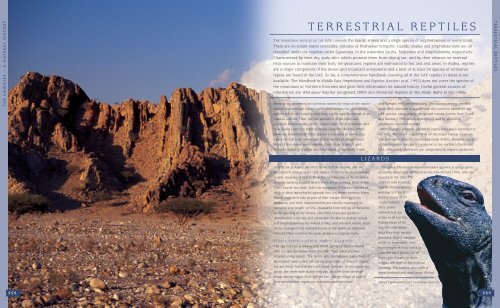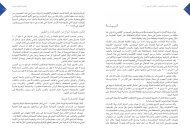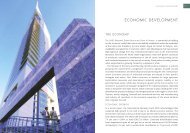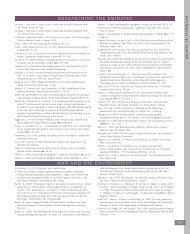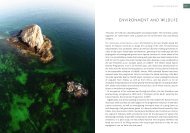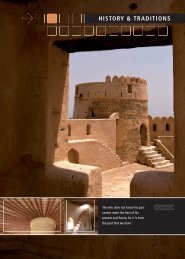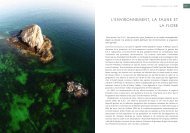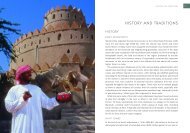TERRESTRIAL REPTILES - UAE Interact
TERRESTRIAL REPTILES - UAE Interact
TERRESTRIAL REPTILES - UAE Interact
You also want an ePaper? Increase the reach of your titles
YUMPU automatically turns print PDFs into web optimized ePapers that Google loves.
T H E E M I R A T E S – A N A T U R A L H I S T O R Y<br />
<strong>TERRESTRIAL</strong> <strong>REPTILES</strong><br />
THE <strong>TERRESTRIAL</strong> <strong>REPTILES</strong> OF THE <strong>UAE</strong> COMPRISE the lizards, snakes and a single species of amphisbaenian or worm lizard.<br />
There are no extant native crocodiles, tortoises or freshwater terrapins. Lizards, snakes and amphisbaenians are all<br />
classified under the reptilian order Squamata, in the suborders Sauria, Serpentes and Amphisbaenia respectively.<br />
Characterised by their dry, scaly skin, which protects them from drying out, and by their reliance on external<br />
heat sources to maintain their body temperatures, reptiles are well-suited to hot and arid areas. In Arabia, reptiles<br />
are a major component of the desert and mountain ecosystems and a total of at least 54 species of terrestrial<br />
reptile are found in the <strong>UAE</strong>. So far, a comprehensive handbook covering all of the <strong>UAE</strong> reptiles in detail is not<br />
available. The Handbook to Middle East Amphibians and Reptiles (Leviton et al. 1992) does not cover the species of<br />
the mountains or Northern Emirates and gives little information on natural history. Useful general sources of<br />
information are Wild about Reptiles (Jongbloed 2000) and Terrestrial Reptiles of Abu Dhabi (Baha El Din 1986).<br />
There is no agreement on common names for most of the reptile<br />
species and although some locally used names may distinguish<br />
species within the country, they may not be specific enough in an<br />
Arabian context. Thus, the two species of Echis vipers are<br />
generally known locally as the ‘carpet viper’ for E omanensis and<br />
‘saw-scaled viper’ for Echis carinatus sochureki (Hornby 1996).<br />
However, elsewhere all Echis species are known as saw-scaled<br />
vipers (and all have saw-keeled lateral scales) or carpet vipers.<br />
Many of the names in A Complete Guide to the Scientific and<br />
Common Names of Reptiles and Amphibians of the World (Frank<br />
LIZARDS<br />
and Ramus 1995) are misleading. The accompanying checklist<br />
(page 360) attempts to standardise the common names for the<br />
<strong>UAE</strong> species, using widely recognised names, names from Frank<br />
and Ramus (1995) where appropriate, and by providing<br />
alternative names elsewhere.<br />
No nationally endemic species of reptile have been identified in<br />
the <strong>UAE</strong>. This is not surprising as all the major habitat types are<br />
also present in adjacent Oman and Saudi Arabia. However, some<br />
of the mountain species are endemic to the northern Oman and<br />
<strong>UAE</strong> mountains, and hence are categorised as regional endemics.<br />
T E R R E S T R I A L R E P T I L E S<br />
Lizards are probably the most familiar of all reptiles, and are<br />
abundant in almost every <strong>UAE</strong> habitat from city to mountaintops.<br />
A wide diversity of lizards from five families live in the Emirates.<br />
Notwithstanding popular belief, none are poisonous. Most of the<br />
<strong>UAE</strong>’s lizards are small, with the exception of the two species of<br />
dhab or dhub (spiny-tailed agamid) and the desert monitor. Many<br />
lizards shed their tails as part of their escape strategy from<br />
predators, and their measurements are usually expressed as<br />
‘snout to vent length’ or SVL, measured from the tip of the snout<br />
to the opening of the cloaca. The most important guide to<br />
identification is the key and annotated checklist to Arabian lizards<br />
and amphisbaenians by Arnold (1986), and Arnold’s earlier study<br />
of the ecology of the lowland lizards of the Northern Emirates<br />
(Arnold 1984) remains the most detailed ecological study.<br />
CHISEL-TEETH LIZARDS (FAMILY AGAMIDAE)<br />
The agamids are a diverse Old World family of diurnal lizards<br />
with six species known from the <strong>UAE</strong>. They are supremely<br />
adapted to the desert. The family gets its common name from its<br />
specialised teeth which are not set in sockets, as in other lizards,<br />
but are firmly fused to the teeth-bearing bones. In the vegetarian<br />
dhubs, the teeth wear down with age, and the bone develops<br />
sharp cutting edges. Most species can change colour as part of<br />
their temperature regulation or behavioural repertoire.<br />
The genus Phrynocephalus (toad-headed agamas) is a large genus<br />
of mainly desert agamas found across Asia (Arnold 1999), with two<br />
species in the <strong>UAE</strong>. The<br />
Arabian toad-headed<br />
agama Phrynocephalus<br />
arabicus is a small<br />
diurnal lizard of<br />
sandy habitats.<br />
They prefer<br />
warmth and are<br />
active in all but the<br />
hottest hours of the<br />
day. On cold winter<br />
days they may remain<br />
dormant. Highly adapted<br />
to life in loose sand, they<br />
have fringes of long scales to<br />
keep the sand grains out of<br />
their eyes, fringes on their<br />
longest toe, and no external ear<br />
opening. The head is short with a<br />
deep forehead and snub nose. On hot<br />
Leptien’s spiny-tailed lizard Uromastyx leptieni<br />
228<br />
229
T H E E M I R A T E S – A N A T U R A L H I S T O R Y<br />
ABOVE: Phrynocephalus arabicus half buried in the sand<br />
RIGHT: The Sinai agama Pseudotrapelus sinaitus<br />
BELOW: Pseudotrapelus flavimaculatus displaying<br />
days they stand high on extended legs, and limit contact with the<br />
sand by balancing on their fingertips and heels, using the tail as a<br />
prop. They are variable in colour with a pattern of black, white and<br />
rufous markings and tend to match their background, with lizards<br />
from pale coastal sands being much paler and less patterned than<br />
those from red, inland sands. The underside of the tail has a black<br />
tip, which becomes a highly visible signal when the tail is lifted and<br />
curled. Toad-headed agamas can sink into the sand by rapidly<br />
vibrating their bodies, a process sometimes called ‘shimmy burial’.<br />
The spotted toad-headed agama Phrynocephalus maculatus is<br />
slightly larger, less mottled and has distinct brown bars crossing the<br />
body and tail. It prefers harder sandy surfaces and is one of the few<br />
reptiles associated with sabkhas (Loughland and Cunningham 2002).<br />
The Sinai agama Pseudotrapelus sinaitus is a colourful<br />
lizard of the mountains and foothills. Males may be<br />
completely sky-blue, or can have a blue head and<br />
throat with a brown body. Females may lack blue,<br />
but, like juveniles, often have a red crescent-shaped<br />
spot behind the axillae. The ear opening is large<br />
and round. They do not display a gular sac. Fast<br />
and agile climbers on rocks and shrubs, they often<br />
adapt a ‘sit and wait’ strategy in hunting. The<br />
somewhat similar yellow-spotted agama Trapelus<br />
flavimaculatus is readily distinguished by its<br />
heavier build, rougher scales and the presence of a gular sac which<br />
is darkened and inflated as a threat display. The ear opening is<br />
smaller and its dorsal margin is partially covered by pointed scales.<br />
They too can develop blue colour on the back and head, though<br />
this is mottled with cream scales, and the tail is orange. In the<br />
summer these lizards often sit atop Acacia trees or prominent<br />
rocks as a territorial display and to regulate temperature.<br />
Largest of the agamas are the two species of spiny-tailed lizards<br />
or dhubs. These archaic-looking reptiles (sometimes mistaken by<br />
the credulous for small dinosaurs) are hardy vegetarians. A related<br />
North African species can survive a year of fasting and takes a<br />
month to digest a meal (Schleich et al. 1996). It was originally<br />
thought that all <strong>UAE</strong> dhubs were the Egyptian spiny-tailed lizard<br />
Uromastyx aegyptia microlepis, but recently a second species,<br />
Leptien’s spiny-tailed lizard Uromastyx leptieni, has been<br />
recognised from the northern part of the country<br />
(Wilms and Böhme 2000). The juveniles are easy to<br />
distinguish, with leptieni being an overall dark grey,<br />
while aegyptia is lighter grey-brown with yellow<br />
dorsal cross bars and spots. The adults are more<br />
difficult to identify, but leptieni has coarser<br />
scalation and enlarged flank scales. The range of<br />
the two forms meets somewhere between<br />
Sweihan and Jebel Ali. Spiny-tailed lizards live in<br />
colonies and require firm sand, soil or soft rock in<br />
which to dig their extensive and deep burrow<br />
systems. They bask at the burrow entrance, and slowly<br />
change colour from black to white and yellow as<br />
they warm up. Once warm, they may take a<br />
circular walk from the burrow, visiting<br />
shrubs to browse. They are far more<br />
active in the summer, with an activity<br />
peak between 0700 and 1100 (Cunningham<br />
2000a; 2000c). On cooler winter days<br />
they remain inside the burrows.<br />
GECKOS (FAMILY GEKKONIDAE)<br />
Geckos belong to one of the most diverse families of lizards.<br />
While most other lizards are ground-dwellers and active during<br />
the day, the majority of gecko species are nocturnal, some being<br />
amongst the best climbers in the Animal Kingdom. They are the<br />
best represented lizard family in the <strong>UAE</strong>, with 17 species<br />
recorded. They have soft skin with small scales, including those<br />
on the top of the head. The head is typically depressed, with<br />
large eyes. The eyelids are fused together, forming a transparent<br />
spectacle. As they cannot blink, geckos lick their eyes to clean<br />
them. In the nocturnal species, the pupil contracts to a vertical<br />
slit with a series of pin-holes in daylight to protect the sensitive<br />
retina. In the dark, the slit opens wide to catch the maximum<br />
amount of light. The semaphore geckos have vertically ellipsoidal<br />
pupils which cannot contract to a slit. Many geckos are able to<br />
produce calls, and indeed the name ‘gecko’ derives<br />
onomatopoeically from the call of the south-east Asian tokay.<br />
Geckos have remarkable climbing skills, with house geckos<br />
having no difficulty in ascending vertical walls, walking upside<br />
down on the ceiling or even across panes of glass. The gecko toepads<br />
do not use suction. Instead, each of the specialised scales,<br />
called scansors, on the underside of the toes has up to 150,000<br />
microscopic hair-like setae. Each of these branches at several levels,<br />
giving rise to hundreds of saucer-shaped end plates. The total<br />
surface area of these plates is enormous relative to the size of the<br />
gecko. Blood-filled sinuses within the toes press the pads<br />
firmly to every microscopic irregularity on the climbing<br />
surface, ensuring a firm grip and allowing such a close<br />
contact that intermolecular forces give the geckos<br />
a toehold on even the most slippery of<br />
surfaces (Autumn et al. 2000). Non-climbing<br />
geckos, such as the sand geckos, lack scansors.<br />
Two species of leaf-toed geckos of the genus<br />
Asaccus found in the Hajar Mountains are particularly colourful.<br />
The Musandam leaf-toed gecko Asaccus caudivolvulus was only<br />
described as a separate species in 1994<br />
(Arnold and Gardner 1994), and is endemic<br />
to the Musandam region and the mountains<br />
of the eastern <strong>UAE</strong>. Medium-sized and<br />
slender, reaching 62 millimetres SVL, it has<br />
a flattened head with a broad snout and<br />
distinct neck. The toes each have a pair of<br />
scansors which project well beyond the<br />
claws so that the toes appear heart-shaped.<br />
Strictly nocturnal, these geckos live in caves<br />
and crevices in the mountain wadis. The<br />
related, but smaller, Gallagher’s leaf-toed<br />
gecko Asaccus gallagheri, has a more<br />
widespread distribution from Musandam,<br />
Uromastyx juveniles<br />
through the Hajar Mountains to the Hajar ash<br />
Sharqi in central Oman and is also endemic to the region. It lacks<br />
tubercles on the back, and is unusual in that the sexes are clearly<br />
dimorphic. The males have bright golden-yellow tails while those<br />
of the females are banded black and white. Both species glue their<br />
single, hard-shelled and spherical egg to the rock deep in crevices<br />
within caves and cliffs, often using traditional, communal laying<br />
sites. In captivity they lay repeat clutches at intervals of three to<br />
four weeks (Leptien 1996; Leptien et al. 1993; 1994; Vogel 1989).<br />
Another climbing gecko found in the mountains is the common<br />
fan-footed gecko Ptyodactylus hasselquistii. These are large and<br />
long-legged with distinctive toes that have a fan-like arrangement<br />
of scansors. Excellent climbers on cliffs, they can often be found<br />
during the day in caves, deeply-shaded overhangs or ruined<br />
buildings. They also glue their eggs to the rock in communal laying<br />
sites in caves and, in common with the vast majority of gecko<br />
species, lay a clutch of two. Fan-footed geckos usually live in groups<br />
and several are often found sharing the same crevice. They may<br />
be quite vocal, with males in particular calling to each other with<br />
a series of chirrups.<br />
The only other scansorial geckos in the <strong>UAE</strong> are the two<br />
Hemidactylus species. The yellow-bellied house gecko Hemidactylus<br />
flaviviridis is probably the most familiar as it lives in close proximity<br />
with man. These are commonly<br />
observed on walls and under the<br />
eaves of buildings where they catch<br />
insects attracted to electric lights.<br />
During the day they live in<br />
undisturbed corners<br />
of buildings,<br />
such as<br />
Gallagher’s leaf-toed gecko<br />
Asaccus gallagheri<br />
T E R R E S T R I A L R E P T I L E S<br />
230<br />
231
T H E E M I R A T E S – A N A T U R A L H I S T O R Y<br />
RIGHT: Examples of the Stenodactylus species that are present in the <strong>UAE</strong><br />
FROM TOP: Dune sand gecko S. donae, east sand gecko S. leptocosymbotes<br />
and Gulf sand gecko S. khobarensis<br />
BELOW LEFT: Skink gecko Teratoscincus scincus<br />
in air conditioning ducts or even behind pictures on the wall.<br />
Usually solitary and holding a territory, they are relatively large<br />
(up to 95 millimetres SVL) with broad toe pads, flattened bodies<br />
and, sometimes, fat tails. They vary in colour, being an almost<br />
translucent, pinkish-brown at night, but showing a pattern of<br />
dark chevron markings if disturbed during the day. The related,<br />
but much smaller, Turkish gecko Hemidactylus turcicus occupies a<br />
much wider range of habitats from the rough bark of desert ghaf<br />
trees Prosopis cineraria, to rocky outcrops, to the date palms on<br />
city streets.<br />
LEFT: Other gecko species found in the <strong>UAE</strong> include (FROM TOP): banded<br />
ground gecko Bunopus spatalurus hajarensis, least semaphore gecko<br />
Pristurus minimus and rock semaphore gecko P. rupestris.<br />
BELOW RIGHT: Common fan-footed gecko Ptyodactylus hasselquistii<br />
but also hide under surface debris. They have rather short toes,<br />
conspicuous tubercles on the back and flanks and a long barred<br />
tail. A prominent dark stripe through the eye is seen on younger<br />
specimens, but may fade with age. The banded ground gecko<br />
Bunopus spatalurus hajarensis can be found in the mountains and<br />
gravel outwash plains (Leptien and Zilger 1991a; 1991b). They<br />
have prominent dark cross bars and tubercles arranged in six<br />
continuous fine lines down the back. The tail is truncated. The<br />
rough-tailed bowfoot gecko Cyrtopodion scabrum can be confused<br />
with B. tuberculatus, but has the<br />
T E R R E S T R I A L R E P T I L E S<br />
The desert geckos of the genus Stenodactylus illustrate the<br />
tubercles arranged more<br />
adaptation of the gecko toes for different habitats. The largest<br />
regularly and usually has<br />
species, the dune sand gecko Stenodactylus doriae, reaches 83<br />
well-defined dark spots.<br />
millimetres SVL and lives on fine, wind-blown sands, where they<br />
The toes are longer than for the<br />
walk slowly at night, raised high off the surface on their long legs.<br />
other ground geckos, laterally compressed<br />
They have flattened toes with projecting fringes of long scales to<br />
and distinctly kinked. A final diagnostic feature is<br />
increase the surface area in contact with the loose sand. Compared<br />
the presence of two pairs of enlarged scales<br />
to the size of the body, the head is large, probably to accommodate<br />
under the chin. C. scabrum are usually found<br />
very large eyes. Another soft-sand dweller, the Arabian sand gecko<br />
in disturbed habitats such as in towns, oil<br />
Stenodactylus arabicus is much smaller (up to 40 millimetres SVL).<br />
camps and desert farms.<br />
Its webbed toes increase the foot surface area for burrowing and<br />
walking on soft sand. This small species lays a single egg (Leptien<br />
WALL AND SAND LIZARDS (FAMILY LACERTIDAE)<br />
1992). Other desert geckos found in the <strong>UAE</strong> are the east sand<br />
The lacertids are well represented, with at least nine species in<br />
gecko Stenodactylus leptocosymbotes and Gulf sand gecko<br />
three genera in the <strong>UAE</strong>. Lacertids are sometimes known as ‘typical’<br />
Stenodactylus khobarensis, which live on gravel plains and sabkhas,<br />
lizards by Europeans as they are the most common lizards of that<br />
respectively. These species of firmer surfaces have rounded toes.<br />
continent. They are usually small- to medium-sized, diurnal lizards,<br />
Another sand gecko, Slevin’s sand gecko Stenodactylus slevini,<br />
with enlarged scales on top of the head, long, fragile tails and<br />
looks very similar to the dune sand gecko, but has a chevron mark<br />
square or rectangular belly scales arranged in well-defined rows.<br />
on the back of the head, and less flattened fingers. It prefers firmer<br />
They are generally alert and very fast.<br />
sandy plains. Detailed treatment of the sand geckos is given in<br />
Arnold (1980).<br />
The largest, and arguably the most beautiful, gecko in the <strong>UAE</strong><br />
is the skink gecko Teratoscincus scincus, also found in central Asia,<br />
eastern Iran, Afghanistan and Pakistan. Within Arabia, it is restricted<br />
to the northern parts of the <strong>UAE</strong>, being found in areas of low,<br />
undulating sand dunes and<br />
gravel plains. The head<br />
is large and the eyes<br />
are particularly<br />
reflective allowing<br />
the geckos to be<br />
located with a spotlight by<br />
their eye shine, which is visible from<br />
over 150 metres (Osborne 1994).<br />
When disturbed they can emit<br />
a loud hissing sound by rubbing their large overlapping back and tail<br />
scales together. The skin is very fragile and can be autotomised<br />
(discarded) as an escape strategy (Bauer et al. 1989; 1993). Hence<br />
these geckos should not be caught by hand.<br />
In the <strong>UAE</strong> there are three aberrant species of gecko which are<br />
active during the day. These are the semaphore geckos of the genus<br />
Pristurus, so named because they use their tails to signal to each<br />
other. The tiny rock semaphore gecko Pristurus rupestris is the most<br />
common and is found in both the mountains and other rocky areas<br />
and in cities, including Abu Dhabi and Dubai, where they can<br />
sometimes be observed on walls and in gardens. They frequently<br />
interact with other individuals using a variety of signals, including<br />
vertical tail curling, wagging the tail from side to side, tail flicking,<br />
along with various body postures. The precise meanings conveyed<br />
by these signals are not yet fully understood (Ross 1990). Males<br />
have a crest of pointed scales along the top of the tail.<br />
The other species of semaphore gecko also signal with body<br />
postures and their tails, but using different languages of gestures.<br />
The bar-tailed semaphore gecko Pristurus celerrimus is larger,<br />
reaching about 40 millimetres SVL and has a longer, barred tail. It<br />
is found in the Hajar Mountains, and in the limestone mountains<br />
of the Ru’us al-Jibal, where they are abundant, reaching the highest<br />
altitudes (Bischoff 1989; Leptien 1993a). The least semaphore<br />
gecko Pristurus minimus lives on the sand and gravel outwash<br />
plains and on the coastal plains of the eastern <strong>UAE</strong>. This<br />
inconspicuous and tiny gecko (usually less than 27 millimetres<br />
SVL) lives within clumps of vegetation and is easily missed. It<br />
was discovered in the <strong>UAE</strong> in 1989 (Böhme and Leptien 1990).<br />
There are three further species of ground-dwelling geckos in the<br />
Emirates. The Baluch ground gecko Bunopus tuberculatus is an<br />
abundant and widespread species of vegetated sandy plains and<br />
coastal habitats (Leptien 1993b). They dig burrows in the sand,<br />
The five species of fringe-toed lizards belong to the large genus<br />
Acanthodactylus, typically Saharo-Sindian, with species ranging<br />
from Spain, across North Africa, Arabia to Afghanistan, Pakistan<br />
and India (Arnold 1983). Colour patterns are variable and tend to<br />
change with age. The most abundant species in the <strong>UAE</strong> is<br />
Schmidt’s fringe-toed lizard Acanthodactylus schmidti, found in<br />
sandsheets and dunes, wherever there is sufficient vegetation to<br />
support their burrow systems and insect prey. They have highlydeveloped<br />
scale fringes on their toes to aid locomotion on soft<br />
sand. Schmidt’s fringe-toed lizard has a pattern of small pale spots,<br />
and never has longitudinal stripes, even when young. The other<br />
four species all have striping to some degree. A. gongrorhynchatus<br />
and A. haasi are also sand dwellers with well-developed toe fringes.<br />
A. gongrorhynchatus has a narrow snout with swollen nostrils and<br />
a blue tail in immatures. A. haasi is the only fringe-toed lizard that<br />
regularly climbs in small shrubs, and has a yellow tail when young.<br />
232<br />
233
T H E E M I R A T E S – A N A T U R A L H I S T O R Y<br />
The other two species live in the outwash gravel plains in the<br />
eastern <strong>UAE</strong>, and have much shorter toe fringes. Bosk’s fringe-toed<br />
lizard, Acanthodactylus boskianus, is large (up to 95 millimetres<br />
SVL), with highly-keeled dorsal scales giving it a very rough<br />
appearance, while A. opheodurus, the snake-tailed fringe-toed<br />
lizard, is smaller (up to 65 millimetres SVL) with a particularly<br />
long tail, tinged red in immatures. Arnold’s key (Arnold 1986) is<br />
useful for confirming identifications.<br />
The two species of sand lizards in the genus Mesalina are close<br />
relatives of the fringe-toed lizards, but differ in having the nostril<br />
well separated from the first upper labial scale, and lacking the<br />
toe fringes. The Hadhramaut sand lizard Mesalina adramitana has<br />
well-developed longitudinal stripes including a dark stripe along<br />
each side, contrasting with the paler flanks below. It is found on<br />
firmer sand sheets and gravel plains. The slightly larger shortsnouted<br />
sand lizard Mesalina brevirostris is more mottled and is<br />
found in coastal areas from Sharjah to western Abu Dhabi, often<br />
foraging on the beach crest. Observations on their distribution and<br />
behaviour in eastern Saudi Arabia are reported by Ross (1988).<br />
The two species of Oman lizards, now classified in their own<br />
genus Omanosaura (Harris et al. 1998; Lutz et al. 1986), are regional<br />
endemics to the northern Hajar Mountains, including the <strong>UAE</strong>.<br />
Jayakar’s Oman lizard Omanosaura jayakari is the largest lacertid<br />
in the region and is easily identified by its large size (up to at least<br />
200 millimetres SVL) and small blue or grey spots. It is an active<br />
hunter in mountain wadis and hillsides, where it is quite common.<br />
The blue-tailed Oman lizard Omanosaura cyanura is much smaller<br />
and less frequently seen. The dorsal colour of adults may be entirely<br />
electric blue, or this colour may be restricted to the tail, with the<br />
SKINKS (FAMILY SCINCIDAE)<br />
The skinks are medium-sized lizards, often with shiny or iridescent<br />
scales and reduced legs. The scales overlap strongly and are<br />
underlain with bony plates giving their bodies protection from<br />
predators and a rigidity that suits their burrowing habits. Five<br />
species are recorded in the <strong>UAE</strong>. Perhaps best-known and most<br />
often seen is the aptly named eastern sandfish Scincus mitranus.<br />
These handsome lizards dive beneath the sand surface and ‘swim’<br />
through the sand by lateral undulations of their powerful bodies.<br />
When there is no perceived danger from predators, sandfish move<br />
across the surface of the dunes. Their characteristic tracks with a<br />
broad body groove criss-cross the dune slip-faces throughout the<br />
country. Sandfish are superbly adapted to their habitat, with highly<br />
polished skin and a streamlined, chisel-shaped snout to reduce<br />
drag. The body and tail base are thick and muscular. The mouth<br />
is recessed and the ear openings are small, although they have<br />
excellent hearing, used to locate insects such as beetle larvae<br />
moving below the surface. Sandfish have an overall golden-pink<br />
colour, with each scale edged in black. A series of golden bars or<br />
crescents run down the sides of the back, with a further row of dark<br />
bars on the flanks. A very similar species, the Iranian sandfish<br />
Scincus scincus conirostris, occurs in southern and western Abu<br />
Dhabi Emirate. This much less common species lives in sand but<br />
CLOCKWISE FROM TOP LEFT: Four of the five species<br />
of skinks recorded in the <strong>UAE</strong> – Asian snake-eyed<br />
skink Ablepharus pannonicus, eastern sandfish<br />
Scincus mitranus, tessellated skink Mabuya<br />
tessellata and ocellated skink Chalcides ocellatus<br />
has also been recorded on a gravel plain<br />
(Baha El Din 1986). It can be differentiated<br />
by its lack of dark vertical bars on the flanks.<br />
The ocellated skink Chalcides ocellatus is a<br />
brown skink of gardens and farms, with a<br />
mainly coastal distribution in Arabia. It has<br />
been recorded in inland localities in Oman<br />
and at Al Ain (Cunningham 2002b), though it may have colonised<br />
these areas with the spread of agriculture. Secretive, they burrow in<br />
leaf litter, but in suitable habitat they can easily be found by<br />
turning rocks and wood. They are typical skinks with shiny scales<br />
and small limbs. The back has a pattern of black and white scales<br />
forming the ‘eyes’. A similarly-sized skink, though with more<br />
developed legs and lacking the eyed pattern, lives in wadis and<br />
screes in the Hajar Mountains and foothills. This is the tessellated<br />
skink Mabuya tessellata, also found in Yemen and Oman. The Asian<br />
snake-eyed skink Ablepharus pannonicus, even more secretive, also<br />
T E R R E S T R I A L R E P T I L E S<br />
body being uniform brown. Juveniles have a strong pattern<br />
of black and cream longitudinal stripes,<br />
though they too have a long blue tail. In<br />
captivity it laid clutches of three eggs at<br />
intervals of roughly three weeks (Leptien<br />
1995; Leptien and Böhme 1994).<br />
TOP LEFT: Bosk’s fringe-toed lizard Acanthodactylus boskianus<br />
TOP RIGHT: Short-snouted sand lizard Mesalina brevirostris<br />
CENTRE LEFT: Snake-tailed fringe-toed lizard A. opheodurus<br />
CENTRE RIGHT: Blue-tailed Oman lizard Omanosaura cyanura<br />
BOTTOM LEFT: Jayakar’s Oman lizard Omanosaura jayakari<br />
234<br />
235
T H E E M I R A T E S – A N A T U R A L H I S T O R Y<br />
lives in the mountains. A small and slender skink, it lacks eyelids and carrion (Schleich et al. 1996). They either dig burrows with<br />
and is usually only glimpsed as a silvery shape darting into dense their powerful clawed legs or utilise those of other animals, and<br />
cover. The limbs are slender, though well-developed, and it may are most active in the morning and late afternoon, avoiding the<br />
have cream and dark longitudinal stripes down the body.<br />
hottest part of the day.<br />
MONITOR LIZARDS (FAMILY VARANIDAE)<br />
WORM LIZARDS OR AMPHISBAENIANS<br />
By far the largest lizard in the country, sometimes reaching over The single species of worm lizard in the <strong>UAE</strong>, Zarudnyi’s worm<br />
a metre in total length, the desert monitor Varanus griseus has an lizard Diplometopon zarudnyi, is rarely seen, though it is common<br />
elongate body, long tail and sturdy limbs. Juveniles have bold black in sandy habitats throughout the country. Its distinctive trail of<br />
and yellow transverse bands, especially on the tail. Adults are more alternate swirls, left when the animal is moving fast on the surface,<br />
subdued in colour, but the dark bands can still be distinguished is more often observed. Zarudnyi’s worm lizard uses its pointed<br />
amongst a pattern of cream spots and mottling. The head is long, tail as a fulcrum and curls its body forward in a series of lunges.<br />
and the monitors have a forked tongue, flicked in and out like that The name ‘amphisbaenian’ derives from the Greek meaning ‘ to<br />
of a snake to scent the air. They have prominent yellow eyes and walk on both sides’. At first glance both ends look alike, as there<br />
sharp needle-like teeth. When threatened, they inflate their bodies, are no distinct eyes or tapering tail, and this odd reptile looks<br />
hiss and lash out with the tail. They can inflict severe bites which rather like a plump, pinkish earthworm. It spends the day buried<br />
may become septic. They are active hunters, sometimes covering deep in the sand, but at night may move several hundred metres<br />
6–8 kilometres in a day, and have also been recorded swimming on the surface seeking its prey of insects and geckos. They have<br />
in the <strong>UAE</strong> in an attempt to predate on chicks of wading birds excellent hearing and smell, and are effective predators. Lacking<br />
(Khan 1993). Prey is other reptiles, small mammals, birds, insects venom, worm lizards are quite harmless to humans.<br />
SNAKES<br />
Snakes are rarely encountered in the Emirates, despite there being moist soil in gardens. It is occasionally encountered in the <strong>UAE</strong>,<br />
at least 14 species of terrestrial snakes. (For information on sea although probably often overlooked. Despite its appearance, it is a<br />
snakes, see the chapter on Marine Reptiles). Being predators high in true snake, and one with a fascinating way of reproducing. No male<br />
the food chain, they usually occur at low densities in deserts. has ever been recorded (Gasperetti 1988). The females lay small<br />
Many species are nocturnal or cryptic.<br />
clutches of unfertilised, thin-shelled eggs which hatch into miniature<br />
Of the terrestrial snakes, only four are dangerously venomous, snakes, all females. This peculiar way of reproducing is called<br />
while a further three species are rear-fanged colubrids with<br />
‘parthenogenesis’ and is also known in some species of lizards.<br />
relatively mild venom. Although cases of snake bite are very The flowerpot snake is the only snake species known that always<br />
infrequent, it is wise to remember that there are dangerous snakes reproduces parthenogenetically. The species probably originated<br />
inhabiting most parts of the <strong>UAE</strong>, in addition to other venomous in the south-west Pacific region, but has become established on<br />
creatures such as scorpions, spiders, wasps and bees. Sensible oceanic islands such as the Seychelles and Madagascar, and is<br />
precautions include wearing stout shoes or boots in the desert now found in India and Southeast Asia, Africa, Australia, Central<br />
(especially at night), and taking great care when clearing vegetation and South America and Florida. Blind snakes have probably been<br />
and rubbish, collecting firewood or lifting stones.<br />
introduced to Arabia in imported garden soil. It is not known<br />
The key reference work is the seminal paper on Arabian snakes whether they are able to form viable populations in the <strong>UAE</strong>.<br />
by Gasperetti (1988) and much of the information presented here<br />
is drawn from that work. The booklet on Snakes of the Arabian<br />
Brahminy blind snake or flowerpot snake Ramphotyphlops braminus<br />
Gulf and Oman by Michael Gallagher serves as a good introduction<br />
(Gallagher 1993).<br />
TYPICAL BLIND SNAKES (FAMILY TYPHLOPIDAE)<br />
Blind snakes are small, primitive snakes which lack enlarged<br />
ventral scales and have vestigial eyes. Ramphotyphlops braminus,<br />
the Brahminy blind snake or flowerpot snake, is the only species<br />
found in the <strong>UAE</strong>. This is the most widespread snake species in<br />
the world, though looking more like a dark, shiny earthworm than a<br />
true serpent. Harmless and small (up to 170 millimetres total<br />
length), it derives its name from its habit of burrowing in soft,<br />
THREAD SNAKES (FAMILY LEPTOTYPHLOPIDAE)<br />
Thread snakes are the smallest of all snakes. They have no teeth<br />
in the upper jaw, tiny eyes and are generally burrowers, though<br />
some species live in birds’ nests. A single species, the hooked<br />
thread snake Leptotyphlops macrorhynchus, is found in the <strong>UAE</strong>.<br />
This is one of the smallest thread snakes, with a maximum<br />
length in Arabian specimens of less than 200 millimetres, a<br />
diameter of about 2 millimetres, and weighing less than half a<br />
gram. The entire body is pink with no obvious markings, and the<br />
eyes are just visible as small black dots. Burrowers in sand and<br />
soft soil, they are only rarely seen on the surface, usually at night<br />
or when washed out after rain. They are specialist termite<br />
feeders, though may sometimes feed on ants and other small<br />
insects. The hooked thread snake has been recorded at Sharjah,<br />
Dhaid and Al Ain. The tail is at least three times longer than<br />
broad, which differentiates it from the flowerpot snake which has<br />
a tail only slightly longer than broad. A recent report from Iran<br />
indicates that the wadi racer Platyceps rhodorachis may<br />
occasionally feed on thread snakes (Mulder 2002). Hooked thread<br />
snakes also occur in north and eastern Africa, through much of<br />
Arabia and in Khuzistan and Bushahr provinces of Iran.<br />
BOAS (FAMILY BOIDAE)<br />
The single species of boa in south-eastern Arabia, Jayakar’s sand<br />
boa Eryx jayakari, is probably one of the most common snakes in<br />
the <strong>UAE</strong>, and its sinuous tracks are almost ubiquitous in areas of<br />
sandsheets and dunes. Nocturnal and fossorial, it is rarely seen.<br />
Its shape is adapted for burrowing and moving through soft sand,<br />
the chisel-shaped snout, recessed mouth, protected nostrils and<br />
highly-polished scales all reducing friction under the sand, these<br />
adaptations being similar to those of the sand fish, Scincus<br />
mitranus. With its eyes on the top of the head, Jayakar’s sand boa<br />
can remain submerged in the sand and still observe surface prey,<br />
which includes geckos such as the Stenodactylus species, and<br />
Bunopus tuberculatus. It may also eat worm lizards. Unusual<br />
amongst the Boidae, Jayakar’s sand boas are viviparous. An<br />
individual from Saudi Arabia laid seven eggs (six fertile), which<br />
ABOVE LEFT: Hooked thread snake Leptotyphlops macrorhynchus<br />
ABOVE RIGHT: Jayakar’s sand boa Eryx jayakari<br />
BELOW: Wadi racer Platyceps rhodorachis<br />
hatched after 66 days incubation at 31–33 ºC. Hatchlings do not<br />
have an egg tooth (Staub and Emberton 2002). Sand boas have<br />
vestigial hind limbs, visible as claws on either side of the vent.<br />
They have no venom or fangs, and kill prey by constriction.<br />
Maximum length is 64 centimetres.<br />
COLUBRIDS (FAMILY COLUBRIDAE)<br />
The Colubridae is by far the largest of the snake families,<br />
including some 70 per cent of all snake species. Most species,<br />
including those from the <strong>UAE</strong>, are not dangerous to man.<br />
Colubrids with venom are rear-fanged, and inject venom using a<br />
pair or cluster of grooved maxillary teeth around the middle of<br />
the upper jaw. Seven colubrid species have been recorded or are<br />
expected to occur in the <strong>UAE</strong>, of which three are rear-fanged, all<br />
with a mildly toxic venom. Usually long, slender and fast-moving,<br />
they have large scales on the top of the head.<br />
The range of the wadi racer Platyceps rhodorachis includes North<br />
Africa, Arabia and south-western Asia. In the <strong>UAE</strong>, this species is<br />
found in most wadis with permanent water, though they can also<br />
T E R R E S T R I A L R E P T I L E S<br />
236<br />
237
T H E E M I R A T E S – A N A T U R A L H I S T O R Y<br />
live in dry desert regions and mountain-sides. They are<br />
fast, agile and slender snakes, diurnal or crepuscular in<br />
habits. Wadi racers have no fangs, though their saliva<br />
may have a mildly toxic effect (Perry 1988).<br />
Most individuals are less than a metre long. Wadi racers are<br />
highly variable in colour and pattern. <strong>UAE</strong> specimens occur in<br />
two main colour phases; either well patterned and greenishgrey,<br />
or an almost unmarked dull tan. Patterned individuals have<br />
dark grey heads with distinctive creamy markings immediately in<br />
front and behind the eyes. There is a dark band below the eye<br />
and two further dark bars on each side of the head. On the front<br />
two-thirds of the body are up to 100 darker bars over the back<br />
and sides. The ground colour and barring become paler and less<br />
distinct further back, and the tail is usually plain and a pinkish<br />
brown. Unmarked individuals also show the creamy bars in front<br />
of and behind the eyes, and have pinkish tails. The belly is white<br />
with an iridescent pinkish sheen.<br />
In wet wadis, these snakes are often semi-aquatic and hunt for<br />
fish, tadpoles and, perhaps, other wadi racers (Cunningham 2000b;<br />
2002c). A favourite retreat is in small crevices just above the water<br />
level. In Oman, they have been observed feeding on fish on rocky<br />
seashores. They climb with ease on near-vertical rock faces.<br />
Hardwicke’s racer Platyceps ventromaculatus is a species with a<br />
The hooded malpolon<br />
Malpolon moilensis has a range through<br />
Northern Africa from Morocco to Egypt and Sudan, in<br />
south-west Asia from Jordan, Iraq, south-western Iran,<br />
and throughout Arabia. The maximum length is about 150<br />
centimetres, with females being larger and having proportionally<br />
shorter tails than males (Schleich et al. 1996). The hooded malpolon<br />
is a fast-moving diurnal snake with a chequered pattern and large,<br />
hooded eyes with round pupils and orange or red iris. The head,<br />
clearly distinct from the neck, has a pointed snout which protrudes<br />
over the mouth. There are poison sacs and one or two very large<br />
grooved fangs situated just behind the eye, but the snake is not<br />
considered dangerous to humans.<br />
elongate head, and may reach 150 centimetres in length. The eye<br />
is large with a round pupil surrounded by a pale yellow ring and<br />
golden-brown iris. The body pattern is of longitudinal cream and<br />
dark stripes on an olive or tan background. This pattern is variable<br />
with some snakes being conspicuously striped while others are<br />
almost uniform. There is a pair of non-venomous fanglike<br />
teeth in the upper jaw at the anterior edge of<br />
the eye, and one or two pairs of strongly enlarged<br />
and grooved venomous fangs at the posterior edge of the eye. The<br />
prey of lizards, small birds, rodents and other snakes is caught,<br />
chewed to immobilise with the venom, and then swallowed head<br />
first. The venom is not considered dangerous to humans.<br />
These snakes are relatively common in well-vegetated areas,<br />
especially those with trees and shrubs, including areas of cultivation.<br />
Excellent climbers, they are able to catch birds in trees (Handley<br />
and Cunningham 2000). They are also found in sand and gravel<br />
areas with low shrubs and grasses and occur from sea level to the<br />
mountain summits.<br />
The diadem snake Spalerosophis diadema cliffordi is also found<br />
across North Africa, Arabia and eastwards to northern India and<br />
Nepal. It can reach 130 centimetres, though is usually less than a<br />
metre long, and is relatively heavier-bodied than the racers. It is a<br />
voracious feeder on<br />
rodents, though young ones<br />
eat small lizards. The back has a series of dark olive spots, often<br />
edged in white, on a paler, sandy-beige base and there is usually<br />
a dark band (the diadem) running across the head between the<br />
eyes. A series of sub-ocular scales separates the eye from the<br />
labials, a feature distinguishing the diadem snake from all other<br />
colubrids in the <strong>UAE</strong>. Although it strikes readily when cornered,<br />
it has no venom and no serious effects of its bite on humans<br />
have been reported. It is apparently rare in the <strong>UAE</strong> having only<br />
been recorded from the Tayyibah Plain and Al Ain.<br />
T E R R E S T R I A L R E P T I L E S<br />
range around the northern Arabian Gulf, Iraq, Iran, Pakistan and<br />
northern India. It is quite common in Bahrain, but the only <strong>UAE</strong><br />
records are from Sir Bani Yas. Long and slender, these snakes<br />
reach a maximum length of 90 centimetres. Diurnal, they prefer<br />
inhabited areas with water sources, such as farms and date gardens,<br />
where they subsist on rats. Colouration is variable, but there is<br />
generally a series of dark bars or spots down the back on a paler<br />
grey or olive background. There are spots on the flanks, and a<br />
dark bar across the head between the eyes, ending in a comma<br />
shape in a white spot beneath the eye. They have no venom.<br />
The awl-headed or leaf-nosed snake Lytorhynchus diadema is a<br />
small snake, harmless to man, and found in sandy habitats. It has<br />
When disturbed the hooded malpolon lifts the front third of its<br />
a distinctive enlarged rostral scale and head marking consisting of a<br />
body off the surface, holds it at an angle of 45° to the ground and<br />
chocolate brown circle or ring on the parietals, usually joining a<br />
spreads a hood, this behaviour giving rise to reports of ‘cobras’<br />
brown bar between the eyes. The large and sharp-edged rostral<br />
in the <strong>UAE</strong>. Normally diurnal, these snakes may be crepuscular or<br />
scale and the counter-sunk mouth are<br />
even nocturnal during the summer. Found in gravel and stony<br />
adaptations for burrowing<br />
deserts, sandy coastal regions and cultivations, they are apparently<br />
and digging in sand<br />
absent from pure sand deserts and mountains.<br />
for prey.<br />
The Schokari sand racer Psammophis schokari also<br />
has a wide range, from North Africa to Nepal. They are<br />
thin, fast-moving, diurnal snakes with distinct neck,<br />
TOP: Awl-headed or leaf-nosed snake Lytorhynchus diadema<br />
CENTRE: Schokari sand racer Psammophis schokari<br />
LEFT: Hooded malpolon Malpolon moilensis<br />
OPPOSITE TOP: Diadem snake Spalerosophis diadema cliffordi<br />
OPPOSITE BELOW: Arabian cat snake Telescopus dhara<br />
238<br />
239
T H E E M I R A T E S – A N A T U R A L H I S T O R Y<br />
The Arabian cat snake Telescopus dhara has a widespread<br />
distribution in Arabia, and is known from the Jebel Akhdar and<br />
Ru’us al-Jibal mountains in Oman within a few kilometres of the<br />
<strong>UAE</strong> border. It is therefore likely to occur in the <strong>UAE</strong>. Nocturnal, it<br />
has very large eyes with vertically elliptical pupils and is an opaque<br />
greenish-grey or reddish-brown iris. The overall colouration is<br />
pinkish brown, with a highly variable degree of dark marking.<br />
Maximum recorded length is 113 centimetres.<br />
An excellent climber of trees and rock faces, it usually moves<br />
stealthily, feeding on birds, bats and geckos and entering small<br />
cracks in the rock to take sleeping diurnal lizards. It actively hunts<br />
even on cold winter nights when its movements are very slow.<br />
It is rear-fanged and the effects of the venom on man are not<br />
recorded, but it is believed to be only very mildly poisonous. It is<br />
not aggressive and does not generally strike, even when provoked.<br />
VIPERS (FAMILY VIPERIDAE)<br />
The vipers are a major group of venomous snakes, represented in<br />
the <strong>UAE</strong> by four species. Vipers have a pair of shortened maxilla<br />
bones, each of which has a single, long hollow fang. There are<br />
usually one or more replacement fangs on each side which move<br />
into the functional position as fangs are broken or shed.<br />
The maxillae are hinged so that the fangs are automatically raised<br />
when the mouth is opened. When the mouth is shut, the fangs<br />
are folded flat against the roof of the mouth and enveloped in<br />
membranous sheaths. Venom glands typically are large, and the<br />
principal action of the venom is haemotoxic.<br />
Viper bites are rarely fatal in Arabia. In exceptional cases where<br />
death has occurred, this has resulted from inappropriate or<br />
delayed medical intervention. The recommended first aid advice<br />
is to reassure the patient, immobilise the bite site (usually a leg<br />
or arm) with a firmly applied bandage and splint, and take the<br />
victim to the nearest hospital. Do NOT cut or suck the wound,<br />
apply a tourniquet, or give aspirin or spirits. Attempting to kill<br />
the snake is not recommended as this may result in further injury.<br />
Vipers, striking defensively, often do not inject venom.<br />
In all <strong>UAE</strong> species, the upper side of the head is covered with<br />
small, overlapping scales, and the pupil contracts to a vertical slit<br />
in bright light. <strong>UAE</strong> vipers are crepuscular or nocturnal. Heavierbodied<br />
than the other snake families, vipers rely on various<br />
ambush techniques and a lightning-fast strike to catch prey.<br />
Once envenomed, the prey is usually released to die, the viper<br />
then following the scent trail to its meal.<br />
The nominate form of the Arabian horned viper Cerastes<br />
gasperettii gasperettii, is found throughout the sandy deserts of<br />
Arabia from the eastern edge of the Sinai Peninsula, and also<br />
north-eastwards to Iraq and western Iran (Werner et al. 1999).<br />
The Arabian horned viper Cerastes gasperettii gasperettii has a distinctive<br />
pattern of scales (shown in detail in the top photograph) and leaves its<br />
characteristic side-winding tracks in the sand.<br />
and wide, and in some individuals bears a pair of ‘horns’ made<br />
up of single, enlarged scales above the eyes. The sand-coloured<br />
body is flattened and stout, with a short tail. The dorsal scales<br />
Horned vipers are mainly<br />
nocturnal, but may bask on winter<br />
days. They feed on rodents, lizards<br />
and birds, using both an ambush<br />
strategy and active foraging,<br />
sometimes covering more than a<br />
kilometre in a single night.<br />
Two species of saw-scaled vipers are<br />
found in the <strong>UAE</strong>. The Sind saw-scaled viper<br />
Echis carinatus sochureki has a distribution from<br />
Bangladesh across northern India to Pakistan and into<br />
eastern Arabia, where it is only found in the northern <strong>UAE</strong> and<br />
northern Oman. Other related species and subspecies are known<br />
from southern and central Asia, western Arabia and across<br />
Africa. The classification of these snakes is still uncertain. The<br />
maximum recorded length is 61 centimetres,<br />
but most are much smaller. Notwithstanding<br />
its small size, this is a dangerous snake with<br />
powerful venom. It strikes rapidly and<br />
continuously with minimal provocation.<br />
The Sind saw-scaled viper has a more oval<br />
head than the other viper species, and usually<br />
bears a prominent dark-brown arrow-shaped<br />
marking. When threatened, it forms a series<br />
of C-shaped coils which are rubbed against<br />
each other in opposite directions, producing a<br />
loud rasping warning hiss which is amplified<br />
by the inflated body. It may move forward or back during this<br />
threat. The preferred habitat is sand or sandy gravel plains,<br />
including areas of cultivation. In the <strong>UAE</strong> it is only recorded in the<br />
northern lowlands, as far south as Abu Dhabi.<br />
The Oman saw-scaled viper Echis omanensis was only recognized<br />
as a separate species within the Echis coloratus complex in 2004<br />
by Babocsay. It is restricted to the <strong>UAE</strong> and northern Oman. It is<br />
often larger (maximum 75 centimetres total length) and more<br />
heavily built than the Sind saw-scaled viper, and is ususally a dark<br />
brown or grey colour overall with the top of the head being<br />
unmarked. The colour pattern has less contrast, with the pale dorsal<br />
markings being tan or grey rather than whitish. The head is strongly<br />
widened behind the eyes, especially in larger individuals. There<br />
are usually three rows of scales separating the eyes from the<br />
labials, whereas Echis carinatus has two. The two species also<br />
occupy different habitats, with omanensis favouring rocky<br />
mountain wadis and hillsides. They are especially common in<br />
wadis with frequent or permanent water pools, where they feed<br />
on toads (Gillett 1994). A case study of a human casualty<br />
suffering a non-fatal bite, probably of<br />
this species, is described by<br />
Wernery and Lipp (1998).<br />
The fourth viper species, the<br />
Persian horned viper Pseudocerastes<br />
persicus persicus, is widespread in Iraq,<br />
Iran and Pakistan. In Arabia it is restricted<br />
to higher altitudes (usually above 1,000<br />
metres) in the northern Oman mountains from<br />
Musandam to Jebel Qahwan in the Eastern Hajar. It has<br />
recently been reported in the <strong>UAE</strong> from Jebel Hafit and the<br />
Ru’us al-Jibal (Cunningham 2002a). Confined to the mountains, this<br />
species is a relict of a cooler and moister climate. It is terrestrial,<br />
but will sometimes climb into small bushes. When angry, it inflates<br />
the body and hisses loudly, but does not form writhing C-shaped<br />
coils as do the other three <strong>UAE</strong> vipers. It is a<br />
medium-sized, thick bodied snake, with<br />
prominent multiscaled ‘horns’ above the eyes.<br />
In addition to the naturally occurring<br />
species, various introduced species may be<br />
encountered. The pet shops in the cities carry<br />
a range of exotic reptiles including tortoises,<br />
terrapins, crocodilians, lizards and snakes,<br />
and these may escape or be deliberately<br />
released. While the harsh desert conditions<br />
ensure that most species are unlikely to survive<br />
for long, some may be able to establish viable<br />
populations. The Caspian terrapin Mauremys caspica has been<br />
reported in Wadi Shih (Gross 1996) and the ubiquitous American<br />
red eared sliders Trachemys scripta may now occur in permanent<br />
pools and ponds.<br />
There have also been reports of crocodiles living in irrigation<br />
ditches near Dhaid while a dead crocodile was washed up in early<br />
2003 at Jazirat al-Hamra, Ra’s al-Khaimah.<br />
Drew Gardner<br />
T E R R E S T R I A L R E P T I L E S<br />
In the <strong>UAE</strong> they are common throughout the sandy areas, though<br />
their distinctive side-winding tracks are more often seen than the<br />
animals themselves. They are easily identified. The head is flat<br />
have obvious anchor- or club-shaped keels, and the keeled lateral<br />
scales are arranged in oblique rows and can be rubbed together<br />
to produce a loud rasping warning.<br />
TOP: Sind saw-scaled viper Echis carinatus sochureki<br />
CENTRE: Scales of E. carinatus sochureki<br />
RIGHT: Persian horned viper Pseudocerastes persicus persicus<br />
240<br />
241


